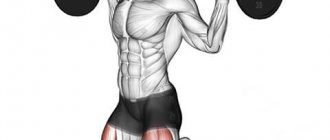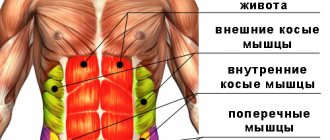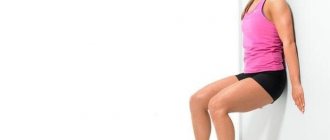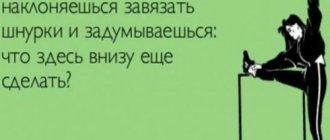From this article you will learn: the causes of knee pain when squatting and standing up, how to treat it. Associated symptoms and the nature of pain in various pathologies and conditions, how to accurately diagnose the problem.
Author of the article: Victoria Stoyanova, category 2 doctor, head of the laboratory at the diagnostic and treatment center (2015–2016).
Article publication date: 06/30/2019
Article updated date: 01/17/2020
Pain in the knee when squatting and standing up (bending or straightening the joint) is not uncommon. This is a symptom that may indicate a disease of the knee joint. According to statistics, about 60% of people experience such pain, which can be due to many reasons.
The most common reasons for this situation:
- Traumas and microtraumas.
- Diseases of the musculoskeletal system (arthritis, arthrosis).
- Excessive constant loads (for example, when working as a loader, mason).
The symptom can occur independently, in isolation. This happens in the initial stages of arthrosis or during intense sports activities. In this case, pain occurs only when bending the knee or squatting.
But most often it is accompanied by other signs of joint damage - a feeling of fullness (with Baker's cyst), pain when walking (Osgood-Schlatter disease) and with exertion (arthrosis of the 2nd degree).
Who may experience a similar symptom:
- people who play sports or actively train (knees hurt due to weight lifting, squats with dumbbells, barbells);
- persons in heavy professions, with constant stress on their knees (miners, loaders, sellers);
- people after 45–50 years (against the background of natural aging of cartilage tissue, which begins at this age);
- overweight men and women.
Men suffer more often from injuries and stress. In 60% of cases this occurs due to heavy physical labor, strength sports and dangerous hobbies. Postmenopausal women are susceptible to chronic joint pathology. Hypoestrogenism (decrease in the level of estrogen - sex hormones) after 50 years increases the chances of developing arthrosis by half.
Discomfort in the knee is usually a sign of pathological changes that can be prevented, stopped or cured (depending on the pathology) if you consult a doctor in time:
- arthrologist, orthopedist - for diseases and stress;
- to the traumatologist - after herbs.
If you do not pay attention to the symptom, over the years you can expect various complications, and the most common is arthrosis of the knee.
Before visiting a doctor, you should reduce the load on the joint: move less, do not play sports, or do heavy physical work. You cannot warm up the joint until a diagnosis is made - in some processes (purulent inflammation, tumors) thermal procedures are prohibited. You can apply ice wrapped in a cloth to the sore joint for 5–10 minutes. For severe pain, non-steroidal anti-inflammatory drugs (Nise, Ibuprofen, Meloxicam) are allowed to be taken, but not more than 3 days.
Causes of pain in the knee joint during squats
One of the most common causes of pain is ordinary physical overload. It can be obtained as a result:
- Excessively intense workouts in the gym. Often, knee pain occurs in athletes who run a lot (football players also fall into this category) and do exercises with heavy weights. Most often, this unpleasant symptom is experienced after squats with a heavy barbell. To avoid pain in the knee joint after training, you need to wisely select the weight, number of approaches, and take into account the condition of the joint. The more it is susceptible to mechanical damage, the less the load should be.
- Standing or physically demanding work. The fact is that the load on the joint itself and the muscles surrounding it remains throughout the day. As a result, he may be sore by the end of the day and the next day. The ideal measure to combat pain would, of course, be rest. A hot bath and massage will help relax your muscles and relieve stress. Static physical activity - yoga - helps to get rid of discomfort. 10-15 minutes of exercise and your health is guaranteed to improve.
Knee pain when squatting can also occur for other more global reasons. Their roots go much deeper and the treatment of such disorders requires more attention.
Discomfort during squats and standing up may occur due to:
- Mechanical damage to the articular apparatus. These can be various bruises, sprains of muscles and ligaments of the knee joint;
- Degenerative-dystrophic changes in the joint. The group of pathologies includes arthrosis of various etiologies and genesis. The essence of these disorders is the gradual destruction of articular cartilage and limitation of joint mobility;
- Inflammatory disorders. This refers to bursitis, various forms of arthritis (rheumatoid, gouty, juvenile, gonoarthritis, psoriatic, and so on);
- Sciatica. Often, with inflammation of the sciatic nerve, pain radiates to the knee area;
- Osteochondropathies. Aseptic (non-infectious) necrosis of cancellous bone, which occurs chronically and gives complications in the form of microfractures;
- Salt deposits. Usually develops against the background of metabolic disorders. Due to salt deposits, the joint becomes less mobile and may hurt;
- Vitamin deficiency. When a joint lacks the substances it needs, the functionality of the joint may be impaired.
However, this is not a complete list of reasons that can cause pain and other unpleasant symptoms.
In order to accurately establish a diagnosis and select effective treatment, you need to consult a doctor.
Proper barbell squat technique
There are many different types of squats: against a wall, on a support, with special equipment - flexible loops, a platform. It is also possible to do a front squat, when the barbell is not at the back, but at the front deltoid.
But for pumping up the muscles of the legs and buttocks, classic exercises with a barbell are most suitable. If you follow certain rules when following them, injuries and pain can be avoided:
- It is imperative to start your classes with a warm-up.
- Place your feet shoulder-width apart, with your toes turned out about thirty degrees.
- Squat down so that your knees are wider than your toes.
- Place the barbell low on your shoulders, at the level of your shoulder blades. If it is higher, the load on the spine and limbs will increase greatly.
- When standing up, first lift your pelvis, then straighten your legs and whole body. It is incorrect lifting that can lead to injury.
If even minor pain occurs, squats should be stopped.
With the right approach to training, you will protect your knees from injury and give your body the necessary relief.
Diagnosis and treatment of knee pain
If joint pain occurs, the patient can consult a rheumatologist, traumatologist or orthopedist. The doctor will conduct an initial examination of the patient and refer him for the tests necessary to confirm the diagnosis. If treatment of the cause of pain in the knee joint is beyond the competence of a particular doctor, he will redirect the patient to another doctor.
To determine the causes of knee pain when squatting, the following diagnostic techniques are used:
- Laboratory research. They usually include blood and urine tests to look for inflammatory factors. Urine testing reflects the concentration of urea in biological fluid, excessive accumulation of which can cause gout.
- Radiography. The main purpose of such a study is to identify osteophytes and mechanical damage to bone tissue.
- Diagnostic puncture. During this analysis, intra-articular fluid is collected, which then undergoes a series of laboratory tests. This is a particularly important analysis in cases where it is necessary to determine the nature of inflammation in the joint.
- Arthroscopy. A non-invasive examination performed using an arthroscope. This is an instrument with a camera that is inserted into the joint through a small puncture. With its help, you can examine the joint from the inside and thus identify the pathological process.
How to treat knee pain?
Knee joint diseases are an age-related problem. It is present in 30% of people aged 50-60 years. Athletes (especially runners, football players and bodybuilders) develop the disease earlier. Are you at risk? Read how to prevent the disease and cure it.
Make sure that your diet contains vitamins C, E, B6, B5 and A. Together they will have a positive effect on cartilage tissue cells: they neutralize substances that cause cartilage destruction and promote the restoration and growth of cartilage tissue.
Joint deformity due to flat feet
Flat feet are a dangerous disease. This causes the foot to land incorrectly on the supporting surface. This negatively affects the entire skeleton. Flat feet lead to deformation of the big toes, knees, destruction of the hip joints, and headaches. If the problem is ignored, it destroys the knee cartilage.
Heavy stress on the knee due to improper foot position “kills” it over time. With a lack of joint-forming components, this process only accelerates. Therefore, a balanced diet is necessary.
Flat feet need to be treated from childhood, during this period the skeletal system actively grows and changes. This requires special gymnastics. It is more difficult for teenagers to cure the disease. To reduce the negative impact on joints with flat feet, when squatting with a bar or barbell, you need to use special insoles. In adults, the disease cannot be cured, but the condition of the feet can be improved.
Prevention
First of all, to prevent pain, you should remember the need to warm up the knee joints before active physical training. Warming up helps improve blood circulation , as well as abundant lubrication of the joint with articular fluid.
At the same time, it is necessary to remember about proper nutrition and leading a healthy lifestyle . If you are overweight, you should take care of your health and get rid of those extra pounds.
The diet should be rich in useful minerals and vitamins, and you should take care of foods containing calcium.
The amount of water you drink should not be less than two liters per day. Fatty, smoked, fried and salty foods should be excluded from the diet.
Excess weight
Almost all overweight people have pain in their knees after squats. If movements, especially squats, are not yet accompanied by discomfort, then this ease is temporary. Constantly testing your knees for strength will not work, and the joint will definitely make itself felt. This is due to the enormous load that this joint experiences. Unlike the dosed temporary load that a person applies during training, here a person carries his weight constantly.
Pregnant women also face similar sensations. Over several months, their weight increases by several kilograms, while the ligamentous apparatus becomes plastic and therefore less able to withstand the increased load. Pain can appear in the third trimester or manifest itself after childbirth.
Despite the catastrophic lack of time after the birth of the baby, a woman must definitely visit a doctor, undergo an examination and begin treatment, because the baby needs a healthy mother. If you ignore these sensations, pathological processes may develop in the joint. For obese people, the main recommendation would be to reduce weight to normal, as well as take preventive measures to prevent knee dysfunction.
When should you go to the doctor?
Ideally, as soon as you get sick. But we do not live in an ideal world; everyone has urgent matters and everyday concerns. Therefore, you can adhere to the following rules:
- If the pain is severe, you need to go to the hospital.
- If the pain persists for more than 5 days, you should visit a doctor.
- If severe pain occurs after an injury, you should immediately call an ambulance and try not to move.
- If there is an obsessive crunch in your knee, it’s time to rest. After resting, the crunching still persists? To the clinic!
We must remember that knees are not kidneys. With one kidney you can live more or less normally, but with one knee you can’t. Therefore, it is better to play it safe once again and see a doctor.
Joint diseases
If your knees hurt during squats, then the problem may be in pathological processes. In this case, self-medication is prohibited. Discomfort in the knee joint occurs when:
- Rheumatoid arthritis is a chronic disease in which, at the initial stage, aching pain occurs during flexion of the joint.
- Gout. When the disease occurs, the salts in the joint are depleted, which causes sharp pain.
- Deforming osteoarthritis. It causes metabolic abnormalities of the joint, which causes severe pain during physical activity.
- Tendinitis. This is an inflammation that occurs in the ligaments of the knee. Discomfort is observed under heavy loads.
- Knee bursitis. This is inflammation of the periarticular bursa. Pain occurs with active movements.
- Ostechondropathy. Discomfort is felt during active sports, and disappears during rest.
- Arthrosis. This is a disease characterized by the destruction of cartilage tissue. Without treatment, disability occurs. Pain occurs at rest.
If your knees hurt when squatting, treatment should only be performed by a doctor. Therapy is prescribed after identifying a disease that causes unpleasant symptoms.
The best drugs
The list of medications and duration of treatment are determined by the disease. Doctors often prescribe the following medications:
- Non-steroidal anti-inflammatory drugs. They eliminate active inflammation, in which other means may be ineffective. In medicine, NSAIDs containing acetylsalicylic acid, phenylbutazone, etodolac, indomethacin, and diclofenac are used. Although the drugs have a strong anti-inflammatory effect, they cannot be used for a long time.
- Corticosteroids. They are used when previous drugs did not have the desired effect.
- Non-narcotic and narcotic analgesics. Their main task is to eliminate the main symptom – pain. Non-narcotic drugs (Paracetamol, Analgin, Metindol) do not interfere with respiratory function and do not lead to addiction compared to narcotic analgesics (opiates, codeine). Such drugs have a less pronounced analgesic effect and are sometimes useless for severe pain. Narcotic analgesics also help with severe discomfort, but are rarely used.
- Muscle relaxants. These are medications that relax the muscles around the knee joint. It often happens that muscle spasm is considered an additional cause of pain. The best muscle relaxants are Myocain, Sibazon, and Mydocalm.
- Chondroprotectors. The drugs nourish the joint with glucosamine and chondroitin. These components are important for the structural integrity and health of the joint. They are found in joint tissue and intra-articular fluid. These medications are taken for a long time – from 1 month to 3 years.
What should you pay attention to?
To prevent disability, you need to be attentive to the body and the symptoms it gives. If your knees hurt, you need to do this:
- Determine when this happens - during squats, after them, while walking or running.
- Determine the nature of the syndrome. The pain can be pulling, stabbing, throbbing.
- Determine the duration. The pain appears for a couple of seconds, minutes or lasts for a long time.
If discomfort is associated with exercise, you should check:
- rules for performing exercises;
- positioning of legs and distribution of loads;
- intensity of load on the joint.
If the problem is not in technique or correct position, but in heavy loads, you need to choose a replacement for squats. And when the discomfort is not associated with stress, you should visit a doctor. He will determine why your knees hurt when squatting.
Exercise therapy
Physical therapy can be used for treatment or prevention. For healthy joints, moderate stress is required. Physical exercise strengthens muscles and gets the blood pumping. As a result, the frame that supports the joint gains tone. The joint is perfectly saturated with oxygen and valuable components.
Moderate exercise is effective for the elderly. The list of exercises and the number of approaches depends on the disorder. But there are activities that are useful for almost every person:
- "Scissors".
- "Bike".
- Raising your legs while lying on your side or back.
- Stretch your knees forward in a sitting position.
Yoga and swimming are effective for joints. These sports provide moderate exercise and are not too strenuous. If your knees hurt, you need to be careful about running, exercise equipment, and powerlifting. These activities put a lot of stress on the joints, which can only worsen the pathology.










